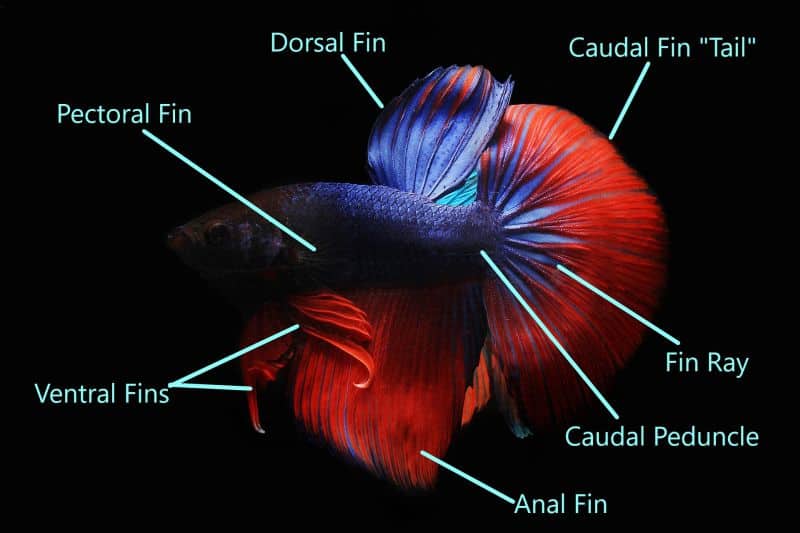Last Updated on October 6, 2020
We can all agree that the Betta is a popular aquarium pet fish. Bettas have captured the awe and admiration of hobbyists ever since the discovery of these fishes. Through a process called selective breeding, betta fish enthusiasts have successfully produced a lot of variants.
Let us discuss each type of Betta fish. Getting to know the different types of Betta fish will help you pick what type is your favorite.
Table of Contents
Types of Betta fish based on Tail Morphology
The tail of the Betta fish is one of its eye-catching body parts. The technical term for this is the caudal fin. It attaches to the main body through the caudal peduncle. Breeders classify Bettas based on the shape and the size of its tail. We will discuss the features unique to each tail type.
Plakat
Plakat comes from the Thai word “Plakad“ meaning fighting fish. Thailand is the country of origin of the Betta species. Siam was the original name of Thailand, hence the name Siamese Fighting Fish. This type closely looks like the Betta fish found in the wild. The Plakat have short and round tails. Their fins are also short when compared to other types of Betta fish.
Veil Tail
Veil Tail features a long, flowing, drooping tail that descends like a gown. This is the most dominant tail type among the other variations.
Half-moon
The Half Moon Tail looks like a halved circle making a 180-degree tail spread.
Over Half Moon
This is a variant of the Half Moon but the tail may even extend the spread beyond 180 degrees.
Half Sun
This is slightly similar to the Half-moon but these have fin rays extending beyond the caudal fin’s membranes resembling the rays of the sun.
Rose Tail
This is a variant of the Half Moon which features far-reaching branching out of fin rays giving it an overlapping effect seen on rose petals.
Feather Tail
This is a variant of the Half Moon which features even more branching compared to the extensiveness of the Rose Tail. This creates an appearance seen on ruffled avian feathers.
Crown Tail
The Crown tail appears like a crown floating sideways. The fin rays are extensive and have less than 2/3 of fin webbing membrane present starting from the caudal peduncle. The fin rays extend like spikes. The dorsal and anal fins will also feature this appearance.
Comb Tail
This is slightly similar to the Crown Tail but has over 2/3 of the fin webbing membrane present starting from the caudal peduncle. It is usually the result of a Crown Tail breeding with another type of Betta variant. It looks like a comb with a fan-like caudal fin and the spread is less than 180 degrees. The rays are long and thin. These extend beyond the fin webbing giving a slightly spiky look.
Double Tail
The Double Tail has a separation of the Tail from the base to the apex. This results in two caudal peduncles. This is a mutation that breeders have taken advantage of to produce a different variant.
Spade Tail
The shape looks similar to a spade where the base of the wide caudal fin ends at a midpoint opposite to the caudal peduncle.
Delta Tail
This type starts narrow from the caudal peduncle and flares or widens towards the end of the tail giving it a triangular form. A subtype is the Super Delta Tail which will flare up to 160 degrees but not reach 180 degrees like the Half Moon type.

A different type of Betta based on its “Ears”
There is Betta classified as Dumbo Ear / Elephant Ear because its Pectoral fins look like elephant ears. Dumbo is also the name of a popular Elephant cartoon character.
Types of Betta fish based on Body Color and Pattern
The variety of colors Bettas present are the reason these fish are so attractive especially for beginners and seasoned fishkeepers alike.
Albino
Albinism mutation is rare in Betta fish but it can happen. The body is white and the eyes are red or pink.
Bi-Color
This color pattern is common in Betta fish. One color will be on its fins and the other color will be on the scales of its body.
Butterfly
Two to three colors are present. The colors will not blend into each other and will cut off into separate portions from the head to back in a vertical pattern.
Black
The Black Betta is also a striking color, especially when placed in a well-illuminated tank. Melano Black Bettas are the darkest.
The gene carrying the Melano trait has to come from the Male because the females produce eggs that rupture during fertilization.
Black Lace Bettas are less dark compared to Melanos but the females can breed and produce eggs that become fry. These Black Lace have more purple and blue highlights.
Metallic Black Bettas have the black melano trait crossed with the copper trait. This produces a Black-Gold effect.
Blue
We commonly see this color sold in local fish stores. It comes in distinct shades of blue such as the iridescent Royal Blue, Steel Blue which is almost gray, and the Blue-wash type color which may have unique shades of blue.
Cambodian
The Cambodian betta is a very specific bi-colored fish which is now becoming rarer because of cross-breeding. The Cambodian betta has deep red fins while the body is skin tone.
Chocolate / Brown
It has a brown body while the fins are either yellow or orange.
Copper / Gold
It is hugely iridescent with scales that seem to look like gold or copper.
Dalmatian
The body of the betta is usually white with spots of color either red or black. Breeders named this type after the popular dog breed.
Dragon
This fish looks like it is wearing armor resembling a lizard or a dragon. The face is always metallic and the scales look outlined in black. The fins will also be mostly black.
Full-Mask
Full mask bettas have a black face while exhibiting other variations.
Green
Most commonly they are turquoise. A darker coloration masks the green pigmentation which appears only under bright light. True green and dark green variants exist but are very rare and often considered precious.
Koi
The Koi Bettas have a marble pattern of whites, reds, and oranges like that of the popular Koi fish.
Mustard Gas
This is a bi-colored variety with a body that is dark blue, steel blue, or green while the fins are yellow or orange hence their name.
Opaque / Pastel
The Opaque Pastel hue is because of a gene that overlays white milky color over a base color.
Orange / Tangerine
This is a rare color type that shows its full effect under full-spectrum illumination.
Purple
True purple betta fish doesn’t exist yet. Those with violets or purplish-blues mixed with copper iridescence are what’s available.
Red
This color is dominant in Bettas. A washed off Red may show that the Betta is not healthy and is a sign for you to check and fix the tank’s water conditions.
Wild-Type
Similar to Betta fish found in the wild. The colors are an iridescent green or blue body with fins of red with or without blue color.
Different Types of Betta fish based on Species

The Betta fish most commonly seen in local fish stores belong to the species Betta Splendens. This species usually comes to mind when you speak to someone about Bettas. There are other species which some Betta fish enthusiasts add to their collection.
Also known as Betta Smaragdina, the Emerald Green Betta is native to Thailand and Laos. It belongs to the Osphronemidae family and grows to about 7 cm.
Also known as Betta Imbellis, the Crescent Betta or Peaceful Betta is native to Southeast Asia where it occurs naturally in Southern Thailand, Malaysia, Indonesia, and now in Singapore. Its natural habitats are stagnant shallow waters in swamps, rice paddies, pools, and ditches. It can grow up to 2 inches.
